I’m no stranger to medium format photography. I’ve owned a few box cameras, a basic folding camera, and a cheap TLR for a while. Last year I started to take it seriously by buying a Mamiya RB67 outfit. I’ve been using it mainly for landscape photography and perhaps inevitably, I ran into the need to have movements on the camera.
I don’t have a scanner or an enlarger capable of taking 5×4″ negatives, and with the added cost of the sheet film, it would be an expensive venture. So I decided to buy a medium format technical camera, aka field camera. After looking around, I settled on one of the Horseman cameras – 970, 980, 985, VH or VH-R.
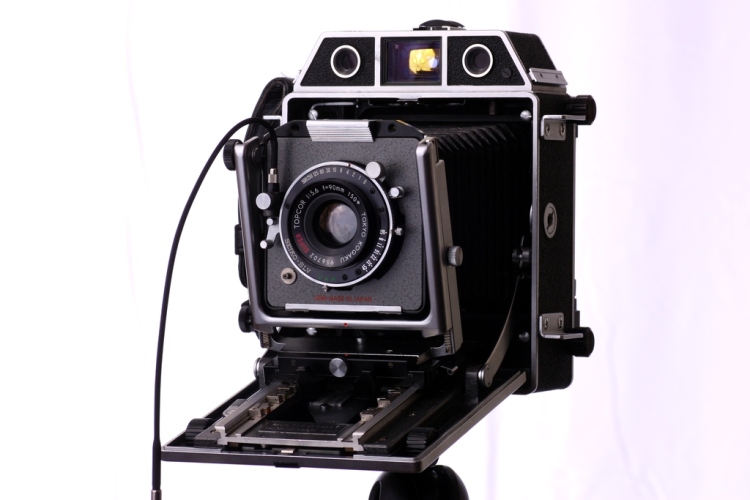
But this isn’t my life story, nor is it a review of the Horseman 980. This is supposed to be a few snippets of information that I have found out for myself about the 980, and have decided to publish here given the scarcity of information about the Horseman 6×9 technical cameras.
Mamiya RB67 backs
Compatibility with RB backs is an important factor for me, since I already have several Mamiya backs for my RB67. Information is hard to come by, but as far as I can gather…
| Will work with RB backs | Will not work with RB backs |
|---|---|
|
|
I think this can be roughly summarised to say that the Horseman cameras with rotating backs can take Mamiya RB67 backs. The older ones can’t.
The baby Graflok mechanism is the same, but the older Horseman models have raised silver metal areas around the film gate that do not allow the Mamiya backs to get close enough to the camera body for the sliding Graflok blades to mate. To mount a Mamiya back on a Horseman 960, 970 or 980 you will need to modify the camera itself. I haven’t seen a later Horseman body to compare.

Film counter
This note particularly concerns the older roll-film back (pictured) with a chrome knob advance rather than a lever – although I have no idea if the same also applies to the lever-advance backs.
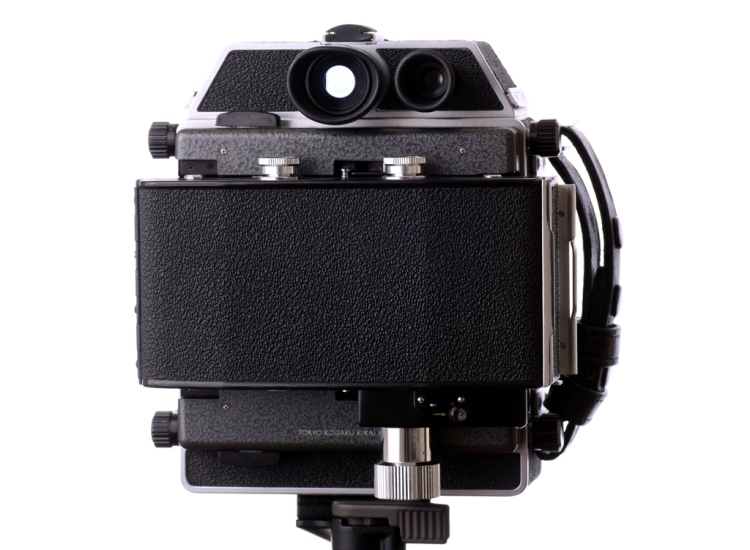
When loading a new film, there is no painted or engraved mark to align with the arrow on the paper backing. Instead you have to wind the paper on until you see the arrow peeping through a hole in the pressure plate. At this point, you close the back and wind until number 1 appears on the film counter.
However, in my experience, this means the film is wound about 5cm too far before the first exposure, meaning the last exposure is cut off. Now that I’m aware of this, I’ll just advance a little less to begin with. After I’ve figured out the best way of doing this reliably, I’ll comment on this post.
Shutter release
These Horseman cameras do not take a standard cable release. The standard type of cable release found on 99% of (non-digital) cameras has a small screw thread on the tip of the cable, and screws into a socket somewhere on the camera or lens. There is no threaded socket on the Horseman lenses. Instead, there is a tube that the cable release sits in, with a screw clamp to hold the cable in place. Sounds OK, except the diameter of the tube is 6.5mm and almost all cable releases are too thin to be gripped by the clamp.
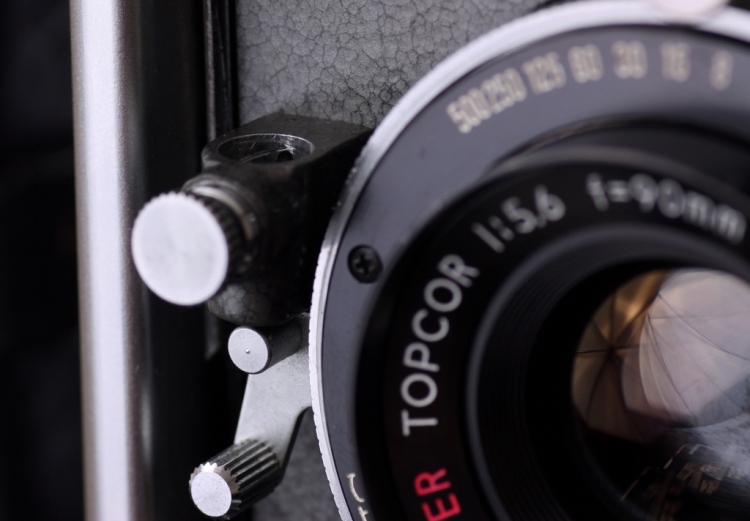
The Horseman cable releases seem extremely rare – I haven’t found one anywhere online. There is also an adapter that exists but is very rare. I’ve searched extensively and found them only occasionally supplied with lenses – never on their own. I’ve pinched this photo from an eBay auction, to illustrate what the adapter looks like. It’s the small chrome thing in the shutter release hole.
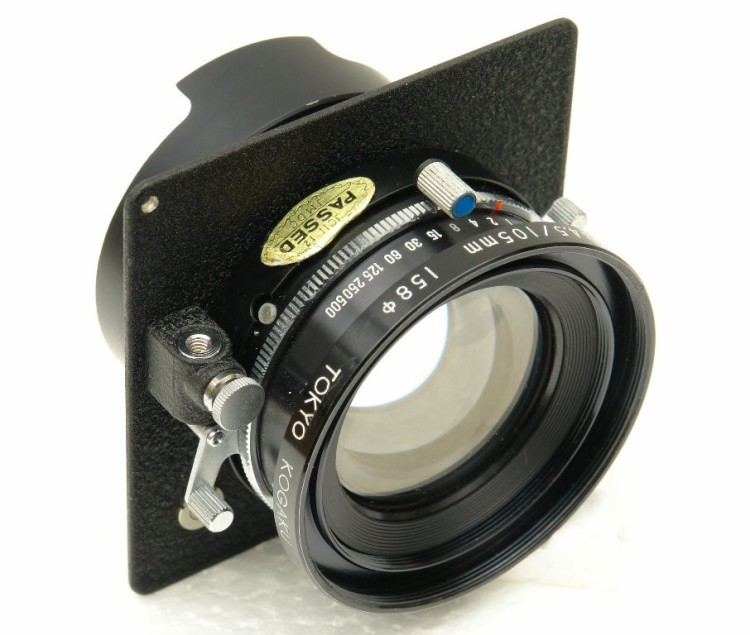
I’ve contacted the Analog Photography Users Group and a camera shop that sells Horseman accessories, but neither were able to offer any insights.
I have worked around this by taking a standard cable release and wrapping it in a few layers of electrical tape to fatten it up a bit, so it gets clamped in the Horseman shutter release. It works reliably enough for me, and even looks OK when mounted.
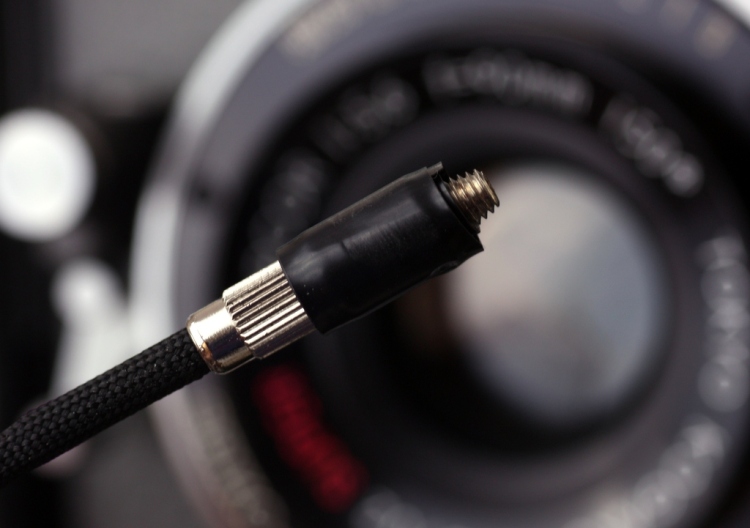
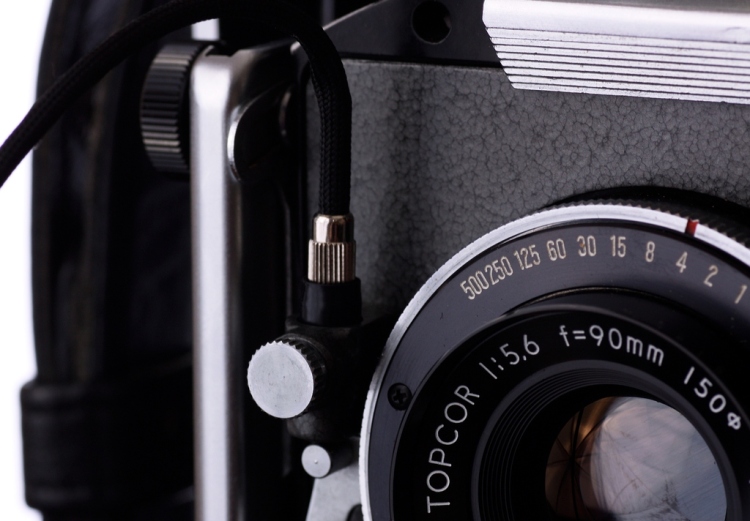

Hi Johnathan,
Quite interested to read in your blog the Horseman VH-R will work with RB67 backs! I am trying to figure out how to mount a Sinarback eMotion75 digital back on a Horseman VH-R to use as a hand held MF digital rangfinder. User changeable mounts for this digital back do include Mamiya 645 and RB67 but am not sure if either of these would work on Horseman VH-R, so would like to ask what you think about this? Also, have you tried to use the VH-R hand held and focus with the rangefinder? Did it work or was it like trying to hand hold a kitchen sink and focus with a donut?
LikeLike
Hi Peter,
Glad you think my blog is interesting – you must be in a minority 😉
If RB67 backs work on a VH-R then I don’t see why a digital back adapter wouldn’t work. It’s a standard baby Graflok fitting with the same sliding blades to keep the back against the body. It’s just that the older Horseman cameras had extra metal ridges that get in the way.
By the way, I’ve never mounted an RB67 back on a VH-R with my own hands – only read that it is possible while researching. I wanted to buy a VH or VH-R myself but none were available at the time I was in the market, so I settled on a 980. I can say with certainty that the 980 won’t take an RB67 back 😦
I did once attempt to use the 980 handheld, but it was too heavy to hold steady, lacked decent hand grips, was too inconvenient to set shutter and aperture dials at the front. The rangefinder did work nicely, but overall the whole camera felt too fragile and I was worried I’d slip and stick my fingers straight through the bellows.
I think that hand-holding kind of misses the point of high-quality photography, so the benefits of medium format are wasted. If I’m handholding, I’ll take one of my old 35mm SLRs or a 35mm rangefinder – have a look at my selection of classic cameras. It’s not quite hand-holding, but with a neck strap the RB67 rests nicely on my belly and is quite stable. That’s the camera I’d take if I needed medium format but didn’t have the luxury of a tripod.
Let me know how you get on 🙂
LikeLike
typo! I meant to write the eMotion75 MFDB can be configured with RZ67 mount but wrote instead RB67
LikeLike
Ah, RZ67. That changes everything. I’ve never used an RZ camera or back so I don’t know if the backs are physically compatiable.
Also I don’t know how a digital back works on a camera with no electronics. How does the back know when to expect the shutter to fire? Maybe this is a daft question – I’ve never used a digital back 😦
LikeLike
Thanks for the quick reply Johnathan!
“It’s a standard baby Graflok fitting..”
Now that is what I need to know. For some reason adapter plates for mounting digital MFDB on standard baby Graflok seem to be as rare as hen’s teeth, don’t know why as they should work well together. Have come across mention of baby Graflok to 4×5 Graflok adapters but they also seem to be extremely rare collectors items these days, so back to the drawing board…
What you say about hand holding the Horseman makes sense. What interests me more is how the rangefinder system of the Horseman or a similar camera (if there is one?) would permit me to focus with my MFDB mounted directly on a MF-LF camera with a single adapter plate rather than having to go the far more expensive and bulky route of using a sliding adapter with GG to focus or even worse having to remove the GG to mount the MFDB every time I shoot.
For many years before moving to digital I worked with a Crown Graphic 4×5 that I still have stored in my cupboard and also I think somewhere in a corner of my heart 🙂
LikeLike
There were a couple of other technical cameras with coupled rangefinders but I think they are more expensive than the Horseman cameras. I can’t remember what make they were, but I think I searched for “6×9 technical camera”.
My 980 doesn’t seem to have any way of reading off the focal distance, but my RB67 does. You might be able to use a handheld or shoe-mounted accessory rangefinder to find the distance, and then dial that distance into the RB67, using the focusing scale on the side. This would avoid having to remove the MFDB but might not be quite so accurate. You’d need to stop down a bit, I guess. Of course the disadvantage of the RB67 is that it doesn’t have movements.
For what it’s worth, when I’m working with the Horseman I remove the groundglass and swap it for the film back each time. It’s laborious and time-consuming, but I think it helps me to take better photographs. Let’s face it, 120 film isn’t cheap these days and if I shoot too much of it, I’ll be out on the street!
I’d love to have a go with a 4×5 camera some time. I keep toying with the idea of moving into large format, but I don’t have the room for a 4×5 enlarger. My 6×7 enlarger takes up enough room as it is 😦
LikeLike
it is me who is asking the daft questions!
Here is how a digital back works on a LF camera with no electronics:
http://www.kapturegroup.com/phase/phase.html#4x4one_a
LikeLike
Before going digital I ended up using this flextight scanner to scan my 4×5 negs rather than an enlarger and still use this scanner today whenever I want to dust off one of my old negs.
http://www.ebay.co.uk/itm/Imacon-Flextight-Precision-Scanner-/280748987714
This “legacy” scanner still works great but I agree nothing beats the thoughtful methodical process of working with film both in the field and the darkroom — if you can get hold of film and have a darkroom to print it in.
Mostly I do portraits that I used to manage fine with 4×5 film holder and the standard Graflok revolving back on my old Crown Graphic but consider it would take much longer to swap a GG and MFDB (hmmm…maybe not?) than to slide a 4×5 film holder into a Graflok revolving back.
Plus there is the fear I would most certainly drop the MFDB in mud though never did this with any 4×5 film holder… it is just that the MFDB costs slightly more than a used film holder and is less easy to rinse off under the tap if I did drop it in the mud 🙂
LikeLike
Isn’t using a MFDB on a large format camera just like putting diesel in a Ferrari? 😛
I’m young enough that I was brought up entirely on digital photography, so for me analogue photography has only been a hobby for the past 2-3 years. I’ve learnt a lot by talking to older and wiser photographers but mainly I enjoy spending time in my darkroom and experimenting. If I want to shoot digital, I’ll take out my DSLR but otherwise I enjoy a fully computer-free workflow (except for low resolution scans for my photo blog).
Anyway, good luck finding the magic component to fix your MFDB to a Horseman or similar. Keep in touch, and let me know how you get on. 🙂
LikeLike
thanks and good luck to you too
LikeLike
A couple of points-
1)There are several system cameras that will accept 2×3 Graflok style backs. I own many, perhaps most of them. Broadly (applies to most of this response):
a)2×3 Graphics (late 30s on)
b)Graflex XL
c)Mamiya Press with fixed G backs (includes the Super 23, albeit rare)
d)Mamiya Universal with G adapter (rare part, often pricey)
e)Mamiya RB67 with standard rotating adapter in several versions
f)Mamiya RZ67 with G adapter (rare part, often pricey)
g)Horseman technical cameras, as above
h)There are 4×5 -> 6×9 reducing backs. All have limitations, many shift the imaging plane.
i)It is possible that some 2×3 Graflex SLRs were converted. I do not know. I do know that my Super D 4×5 has what appears to be a factory installed Graflok back (and I do know factory installations were done).
j)Arca Swiss monorails (including reflex type)
…and there are others (e.g. Silvestri).
2) As far as rollfilm backs go:
a)Graflok 2? / RH?? in all their knob/lever/roller pin variations
b)Graflex backs. These will work as Grafloks, but will slide off to the side without a bit of a hack (you need to make an indexing ridge)
c)Early RB67 backs. Much more rounded than later models. Best balance of modern flatness and light tightness.
d)Late RB67 S/SD backs. Heavier, more interlocks. I believe I have an example of all RB67 back models except the two part motor backs (quite intentionally so).
e)Toyo/Horseman/Wista backs. Often have (removable) screw posts to hitch into the retaining arm.
f)Arca Swiss backs. Unlike the above, I don’t own any examples. Look very much like the Japanese backs without the posts.
In general, the younger the back, the more compatible. I’ve never had a camera not work with a Graflex (company, not back style) back. RB67 original backs are very much the same; I have everything but one of those on hand at the moment – but these are ideal for use on Press/Universals. When I find it, I’ll try it on my 970. If memory serves, they work. There are no hard and fast rules beyond that. I should make a chart.
3)A Horseman 980 (or any other, excluding the RF-less models) does have a way of providing focus distance. Assuming you are using a lens from the system (e.g. a Tokyo Kogaku 105/3.5) the matching focal length cam dropped in the bed will not only allow the RF system to work, but push a needle along a distance scale. Cams are a pain to find.
3.5) Failing that, I suppose a Vernier scale can be made. Um, good luck? 🙂
4)Lots of companies made RF coupled 6×9 technical cameras. Graphics, Technikas, B&J Watsons, Pressmans, etc.
Adam
(visit) http://lipstadt.com | (like) http://facebook.com/lipstadt | (follow) http://twitter.com/lipstadt
LikeLike
I’m in the market for one of those rangefinders. In your experience, how are the topcor lenses? I have a fuji gw 690 III but was not satisfied with the image quality from the lens. So a hand holdable 6×9 with movements look enticing for me.
LikeLike
I’m really happy with the quality of the Topcon 90mm lens, although it’s the only one in the series that I have used.
The Horseman is a great camera but I wouldn’t really call it handheld. It has a flexible leather handle but it’s hard to hold stable, and too easy to accidentally put your fingers through the bellows. The viewfinder and rangefinder work nicely but setting the controls on the front can’t be done by touch – you need to look at it. The focus knob is on the bottom and awkward to use while handholding. Also you can’t really handhold while using movements because the rangefinder would no longer reflect accurate focus.
My recommendation is to use this on tripod like any other view camera! I don’t have any experience with others cameras with movements, but if I’m shooting medium format and I want to handhold, then I would take my Mamiya RB67. Obviously this has a smaller frame, and lacks movements…
LikeLike
I just purchased a 980. It came with a Horseman 105mm lens on an original lens board. The well where the cable release would go is factory threaded in the bottom of the well. There is no need of an adapter/insert or modification of the cable release. Simply insert the threaded end of the cable release end to the bottom of the well and turn it until it is tight.
LikeLike
Thanks, that’s good to know. Yours must be different from mine then, as my 90mm lens doesn’t have any thread at all.
LikeLike
In 2017 I purchased a 980. To make a complete working system I also purchased a scrap camera, I needed the ground glass screen as the first camera had been used as a range finder only( I’ve now got plenty of spares). The main reason for the 980 was, I had a Linhoff 5×4 for a few years and liked the style. The 980 was the closest I could achieve. 5×4 is rather expensive to shoot in the UK and my wife won’t allow me to install a Kreonite processor in the kitchen, so I get my 6×9’s dev and scan. The 980 is a great camera plenty of movement for me and it will take many types of lenses. My current line up is Fujinon 75mm, Schneider 150mm, Rodenstock 210mm. All work great. I have the cams for many of the lens types but never use them. I prefer to focus with the ground glass then change backs. I use both 6×9 and 6×7. It’s time consuming and in winter cold hands are a problem but it’s worth it. I wouldn’t part with this camera. It’s brilliant!. I don’t shoot digital because I prefer to use my set up time to think about my images. The camera always goes on a tripod, to awkward to hand hold but there again it suits me.
Thank you for your article, all the best.
LikeLike
Late to the party, but I’ve been using my VH-R on a monopod. I have a very lightweight Manfrotto monopod, and a beast slayer, beefy monopod also from Manfrotto. Takes a lot of shake out and also makes rotating the camera to change lens setting a breeze. Just give it a twirl on the monopod and you have easy access.
LikeLike
thanks for your information I just brought one but how do you focus the lens /MICHAEL
LikeLike
You don’t focus with the lens itself, you focus with the camera. There’s a knob that slides the whole base forward, moving the front standard with the lens, and extending the bellows.
There are infinity stops on the lens track to set the infinity position for each focal length. The further forward the lens goes, the closer to you the image focuses.
LikeLike
Hi,
I keep ending up on your site when looking for info on the Horseman 6x9s. For some reason the images in this article don’t load, and judging by the captions they provide some info I would be curious to learn more about, like the old style film back and matters related to the cable release.
You don’t happen to have those images somewhere accessible, Flickr or some other photosite?
All the best,
Thorir
LikeLike
Hi Thorir, sorry about this. I think the missing images are a symptom from when I moved my website to a new provider. I have now reinstated the images on this page – hope that helps!
Thanks,
Jonathan
LikeLike
Great, thanks a lot! And like I suspected, very informative images.
Th
LikeLike
I use a VH-R with satisfaction. I have all the lenses that I find very nice.
It is possible to use it hand held; obviously is a slow process not immune from errors.
LikeLike
hello, I recently purchased a beautiful horseman 670 and surfing the net I found your site, which I find very interesting. I want to ask you: can the 6×9 first type back of the mamiya press be mounted on the horseman? I would buy it on ebay, from the photos it seems to me to be adaptable. you can answer me, thanks costantino
LikeLike
Hi Costantino. Unfortunately I don’t know about the Mamiya Press backs. It is likely that they will fit as they are standard baby Graflok backs. Let me know if you buy it ☺️
LikeLike
I am an old school photographer who trained on 5×4 Linhof cameras in the Australian Airforce. I still shoot 5×4, 6×9 and 6×7 (horseman 980) handheld. It is a lot slower to do but with the right planning it is doable.
LikeLike
Thank you for the information about the Horseman medium format technical camera. It shaped what I bought as a medium format alternative to my MPP 5×4. I must say that I’m very happy with my Horseman VH. I have a 6×9 back for mine, and am impressed with the ease of handling compared with the MPP. Everything is there, just in miniature!
The VH does indeed work with the newer backs. It also works with my 620 roll film back and the 2.25 x 3.25 sheet film holders my Busch Pressman uses, which was a pleasant surprise.
LikeLike
About the cable shutter release, you don’t need to use tape wrapped around the end. At the bottom of the hole the cable goes into, there is a conventional tapered thread. Just push the cable end to the bottom and twist the knurled part and it locks in. No tape needed.
LikeLike
I don’t have this particular camera in my possession any more, but there was nothing at the bottom of the hole – just an empty tube with a screw clamp. Looks like it needed an insert to use the screw type.
LikeLike
I just wanted to say, lo and behold, there is the tiniest threaded hole at the bottom to let you use a standard shutter release cable. I was searching forever for information on this, came across your post (from 2011 holy cow!), and wanted to share/confirm what Mark said!
I found it was easier to screw the cable head in while holding down the release lever.
Let this now exist for the next 10 years for someone to find!
LikeLike
Hi Jonathan,
Just wondering if you know if the Horseman 980 will accept and work correctly with the Horseman 6×12 roll film back?
LikeLike
I wouldn’t think so. The film gate is only 6x9cm so you wouldn’t get a larger image. You might even get light leaks depending on how the film back mates to the camera, although I haven’t studied a 6×12 back to confirm.
LikeLike
An old Horseman catalogue shows a Back Adapter n°22511 which “Allow the transformation to 4×5″ of the Horseman 6×9 cameras. It engages easily as a rollback. It allows 6×12 cm exposures. An economical way to transform a medium format into a large format.”
(I cannot ever log on WordPress and cannot reset my password, sorry…)
LikeLike
Interesting! I wonder if the back standard gets replaced with this one, which has a wider film gate
LikeLike
The accessory expansion back for the Horseman (actually there are two models) fits on the back of 6×9 gate (does not replace it) and offsets the new film plane backwards. To bring the image back into focus, you have to move the lens backwards, and closer to the 6×9 gate, so the gate no longer vignettes the image and the image will cover 4×5 (if the lens design allows). Imagine if you moved the lens far enough back so that the rear element is *in* the 6×9 gate. Here there would be no vignetting at all (by the gate). It has its limitations (the limitation of the camera bellows mechanism to move the lens back). To enable straight on, 6×12, photography, it should be fine.
LikeLike
Thanks for explaining! I didn’t know this but it makes sense now.
LikeLike
Great article and interesting comments 🙂 I just receive my 970 in the mail today! 105mm. Everything seems right; the distance scale seems to match the object distance and rangefinder focus. I’m curious if you have had any luck with the chrome knob film back starting where it should? Is this a known issue on all the chrome backs? Does the knob advance exactly one frame from wherever you start it? I’m guessing it works like the more modern backs, where you push the small level after each exposure to unlock the winding mechanism and advance to the next frame. Thanks again for your efforts!
LikeLike
Hi, thanks for your comment. I no longer have my 980, but I don’t recall having any problems with the back. I used it quite a lot.
Just to check you’re using it properly, you start off with the back open and you gradually advance the film so the start arrow on the backing paper lines up with the marker on the back. Then you close the back and carry on winding until it stops, and that’s ready for your first exposure. After that you just wind normally until it stops each time. And yes the lever is to unlock so you can advance one frame.
LikeLike
Thanks Jonathan; I haven’t loaded the first film yet. I was curious about your experience with the film starting ‘5 cm in’ and cutting off the last frame. I can see where the hole is, so I think I’ll be fine with the loading. My RZ and Mamiya 6 require winding until the ‘1’ appears. You suggested winding a little less, implying that the back’s winding mechanism doesn’t automatically stop at ‘1’ and that I might save a little space on the roll. Any advice, or shall i just try? Warm regards 🙂
LikeLike
Sorry, yes, you’re right. I re-read my own article and I’d forgotten about this! If your back is working perfectly then it should work as I described. I think mine needed calibrating, hence I had to wind a bit less. I’ve got a Mamiya RB67 that works perfectly and a Mamiya M645 that has the same fault as this Horseman back but I’ve never figured out exactly what’s wrong. I suggest just trying to load the film and seeing if yours is OK.
LikeLike
Great article and interesting comments 🙂 I just receive my 970 in the mail today! 105mm. Everything seems right; the distance scale seems to match the object distance and rangefinder focus. I’m curious if you have had any luck with the chrome knob film back starting where it should? Is this a known issue on all the chrome backs? Does the knob advance exactly one frame from wherever you start it? I’m guessing it works like the more modern backs, where you push the small level after each exposure to unlock the winding mechanism and advance to the next frame. Thanks again for your efforts!
LikeLike
Thanks for a very informative and well-written piece! As we speak, a 985 is in the mail for me, and some of the replies were helpful in answering concerns I had about the unique cable release clamp. It didn’t take another 10 years for Brendan’s information to be helpful!
LikeLike
Glad it was useful to you. Enjoy your 985!
LikeLike
Ten years later and I’ve just find this and so much useful information.
Thank you very much!
LikeLike